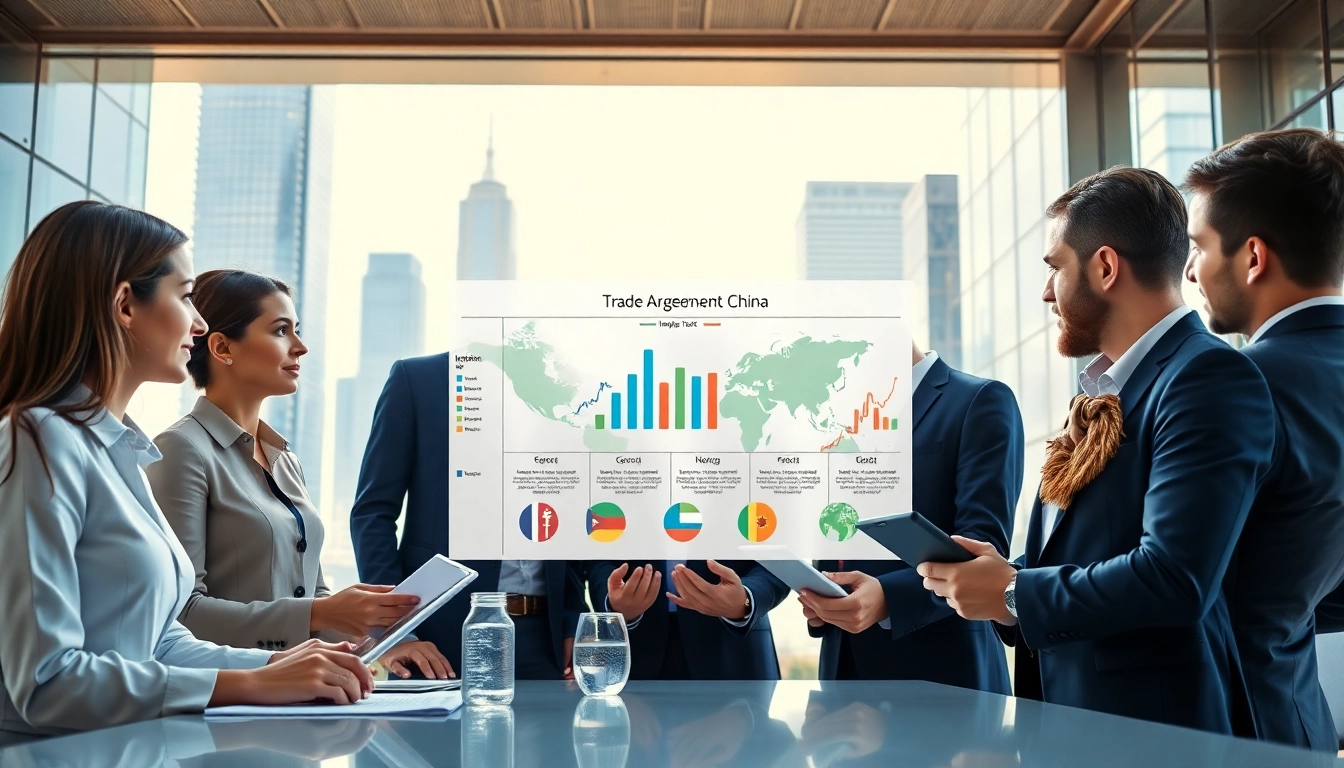Overview of Import Tariffs China
Import tariffs are taxes imposed by governments on goods imported from other countries. As trade relations evolve and economic strategies shift, tariffs have emerged as a critical tool for countries to safeguard their economies, employing them as a means of protecting domestic industries from foreign competition. In the context of import tariffs china, understanding their implications is vital for businesses, policymakers, and consumers alike. This article will explore the intricacies of import tariffs on Chinese goods, their historical context, current rates, and their broader implications on trade dynamics.
What Are Import Tariffs?
Import tariffs are duties levied by a country’s government on imported products. These taxes serve multiple purposes: they generate revenue for the government, protect local industries by making foreign products more expensive, and influence consumer choices within the domestic market. Tariffs can be applied uniformly or vary based on product categories, typically reflecting perceived needs for protection or encouragement of local production.
Historical Context of Tariffs on China
The history of tariffs involving China is intertwined with global trade dynamics, particularly in the last few decades. Following China’s accession to the World Trade Organization (WTO) in 2001, tariffs on Chinese imports significantly decreased, leading to a boom in trade. However, growing concerns about trade imbalances, intellectual property theft, and market access issues have led to an atmosphere of increasing protectionism, particularly in the U.S.
The recent U.S.-China trade tensions have seen a dramatic shift in tariff strategies. For instance, the Trump administration imposed tariffs of up to 30% during its tenure, aimed primarily at certain sectors such as technology, steel, and aluminum. By 2025, various trade agreements and negotiations saw tariff rates fluctuating, indicative of the ongoing tug-of-war between the two economic superpowers.
Key Players in Tariff Implementation
Understanding who plays pivotal roles in tariff implementation gives insight into the political and economic motivations behind such policies. Key players include:
- Government Officials: Leading the charge on tariff policy, their decisions are often influenced by economic pressures and domestic industry lobbying.
- Trade Organizations: Bodies such as the WTO oversee trade rules and agreements, facilitating negotiations on tariff reductions or increases.
- Industry Groups: Various sectors often lobby for tariff protections to shield them from foreign competition, influencing political decisions.
- Consumers: Ultimately impacted by tariffs, consumer behavior can pressure governments to reconsider tariff policies due to increased prices.
Current Import Tariff Rates on Goods
Breakdown of Effective Rates
As of 2025, the landscape of import tariffs on Chinese goods has undergone significant changes. Following the recent U.S.-China trade agreements, a notable provision included a revised tariff rate of 55% on many imports from China, up from previous levels fluctuating between 20% and 30%. The intricacies behind these rate adjustments reveal various economic and geopolitical factors at play.
For example, imports of electronics, textiles, and machinery face different rates, with most being subjected to the newly established 55% tariff. In contrast, goods categorized under essential items or those with no local alternatives are sometimes shielded from such steep tariffs, reflecting a nuanced approach based on industry needs and consumer demand.
Industry-Specific Tariff Impacts
Different sectors experience varying effects from import tariffs. Here is an analysis of a few key industries:
- Electronics: The electronics sector has been significantly impacted due to high tariffs on essential components that often come from China, such as semiconductors. Companies are faced with increased manufacturing costs, which may be passed on to consumers.
- Textiles and Apparel: This industry experiences fluctuating demand based on tariff rates. The significant tariffs can result in higher retail prices and decrease consumer spending in the sector.
- Automotive: Tariffs on parts and vehicles lead to complex supply chains being disrupted, ultimately affecting vehicle prices and availability.
Comparative Analysis: U.S. vs. China Tariffs
A comprehensive comparative analysis of tariffs imposed by the U.S. and China reveals contrasting strategies and economic impacts. While the U.S. engages in higher tariffs on a broader range of imports, China has focused its retaliatory measures on a smaller set of U.S. products, often targeting agricultural goods and energy resources. This asymmetry showcases differing tactical approaches that reflect their unique economic strategies and domestic pressures.
Historically, this tit-for-tat strategy creates a cycle of economic uncertainty that can harm both nations. For instance, with the U.S. holding a significant leverage through its import tariffs, China has had to adapt by seeking alternative markets and suppliers to minimize its exposure.
Implications of High Tariffs on Trade
Effects on U.S. Businesses and Consumers
High import tariffs on Chinese goods have profound implications for U.S. businesses and consumers. The immediate effects manifest as increased prices for consumers, a consequence of companies passing on the higher costs of imports. Sectors most impacted include electronics, automotive, and textiles, leading to price increases of up to 25% for certain goods.
Businesses face not only increased costs but also potential supply chain disruptions. Higher tariffs often motivate companies to reconsider their sourcing strategies, leading to diversification away from China. For many, this transition can be complex and resource-intensive, necessitating time, investment, and a shift in business strategies.
China’s Response and Market Strategies
In reaction to tariffs, China has adapted its market strategies. This adaptability reflects resilience in maintaining trade relationships and economic stability despite tariff pressures. Chinese manufacturers are increasingly focusing on enhancing product quality and diversifying their markets to include regions beyond the U.S., such as Southeast Asia and Africa.
Moreover, China has leveraged its domestic consumption capabilities, stimulating local demand to compensate for reduced exports. The government also continues to invest in technology and innovation, fostering an environment that allows businesses to remain competitive even under the weight of tariffs.
Global Trade Dynamics and Alliances
The high tariffs imposed on China have reverberated throughout global trade dynamics, prompting nations to rethink alliances and trade agreements. Countries such as those in the European Union and those in Southeast Asia have begun exploring closer ties with the U.S. to counterbalance China’s economic influence.
This realignment creates opportunities for countries to foster economic development through regional trade agreements, potentially leading to new partnerships while isolating nations that do not navigate the complexities of these tariffs effectively.
Legal Framework Governing Tariffs
WTO Regulations and China’s Compliance
The World Trade Organization (WTO) plays a crucial role in regulating international trade and ensuring that member countries adhere to agreed-upon rules, including those concerning tariffs. China’s incorporation into the WTO required it to abide by specific regulations, including limiting tariff rates on imports and ensuring fair competition.
However, ongoing grievances regarding intellectual property theft and uneven market access have led to disputes in compliance, leading to calls from various nations for more rigorous enforcement of WTO rules. This ongoing tension may prompt further negotiations at higher institutional levels.
Recent Trade Agreements Influencing Tariffs
Recent trade agreements have significantly influenced the dynamics of import tariffs. For instance, the U.S.-Mexico-Canada Agreement (USMCA) has set a new precedent for trade across North America, potentially leading to shifts in how China negotiates future tariffs with these nations.
Such agreements also provide a platform for countries to address key issues like digital trade, intellectual property protections, and environmental standards, all of which can add layers of complexity to how tariffs are negotiated and enforced.
Future Legal Developments to Watch
Legal developments affecting tariffs are vital to follow, especially considering the fast-paced changes in global trade. Potential future developments may include further tariff negotiations and restructuring of trade agreements that impact the U.S.-China relationship.
Additionally, as the Biden administration sets its policy direction, the adjustments on tariffs influenced by domestic interests and changing geopolitical climates will shape future legal frameworks, requiring continuous monitoring.
Strategic Considerations for Businesses
Adapting to Tariff Changes Wisely
For businesses navigating the realm of import tariffs on Chinese goods, developing a strategic response is crucial. This can include revisiting supply chains, sourcing alternative materials, and entering into new markets. Companies may benefit from conducting market analyses to understand where tariffs can impact their costs and supply lines.
Moreover, establishing relationships with suppliers outside of China can mitigate risks associated with tariff fluctuations. By maintaining a flexible approach, companies can better adapt to sudden regulatory changes, ensuring stability and growth.
Maximizing Opportunities Amidst Tariff Risks
While high tariffs introduce several risks, they also present unique opportunities for businesses willing to innovate. Companies can capitalize on shifting market dynamics by creating local products or leveraging new technologies tailored to address consumer demand for alternatives to tariffed imports.
Furthermore, businesses that take proactive steps to enhance their operational efficiency and reduce their reliance on high-tariff imports can emerge stronger and more competitive in the marketplace.
Conclusion: The Future of Trade between the U.S. and China
The future of trade between the U.S. and China remains uncertain, as ongoing geopolitical tensions and economic strategies continue to shape the landscape. As import tariffs on Chinese goods remain at record highs, both nations must navigate the complexities these tariffs create.
Ultimately, the path forward will require a nuanced approach that balances domestic interests with the necessity for global cooperation and trade navigability. By understanding the implications of tariffs and strategically adapting, businesses can position themselves favorably in an ever-changing trading environment.












Leave a Reply